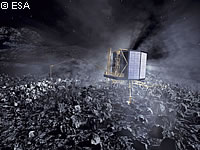Technical difficulties play vital role in choosing Rosetta's comet target
The chief scientist behind Europe's attempt to land a spacecraft on a comet has said that it is now a 'virtual certainty' that Rosetta's target will be Comet Churyumov-Gerasimenko. Gerhard Schwehm explained that due to the extreme difficulty of removing large amounts of nitrogen tetroxide oxidiser from Rosetta, it would be impossible to move the spacecraft from its current position at the European Space Agency (ESA) launch site in Kourou, French Guiana. This in turn means that Rosetta will have to be launched using a standard Ariane 5 rocket, which is not powerful enough to enable the comet chaser to rendezvous with its only other conceivable target, Comet Wirtanen. The only other options for the team would have been either to disassemble Rosetta in order to remove the oxidiser, which they were understandably reluctant to consider, or to use an enhanced version of the Ariane 5 launcher. But following the failure of the enhanced 10 tonne launcher on its maiden voyage in December 2002, it is unlikely that a second flight will take place before spring 2004, and even less likely that ESA would risk including Rosetta as part of its payload. All of which means that Rosetta's pursuit of Comet Churyumov-Gerasimenko could begin as soon as February 2004, with a second window opening a year later in February 2005. The official announcement of Rosetta's new target is expected to be made by the ESA science programme committee in May.



